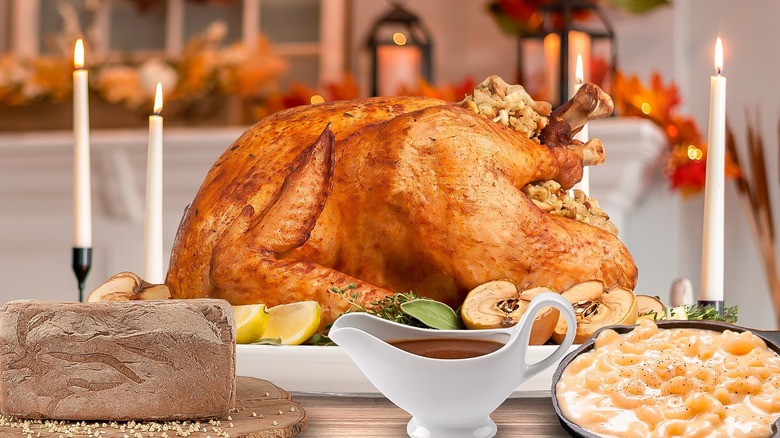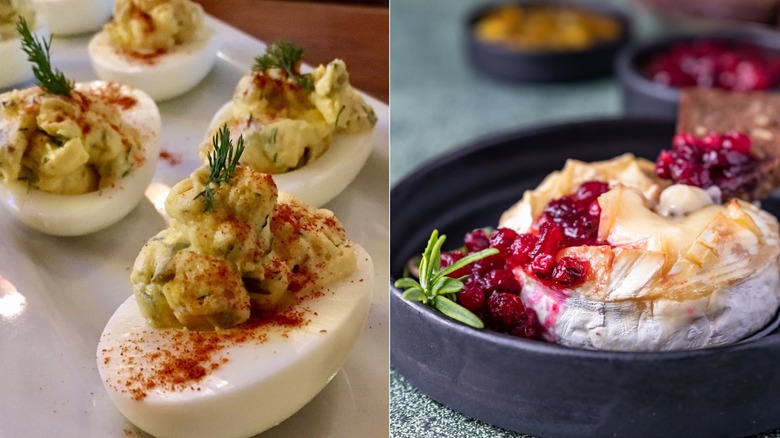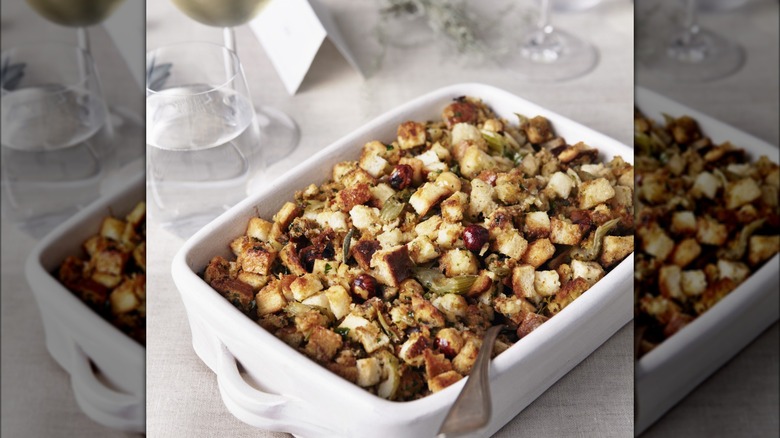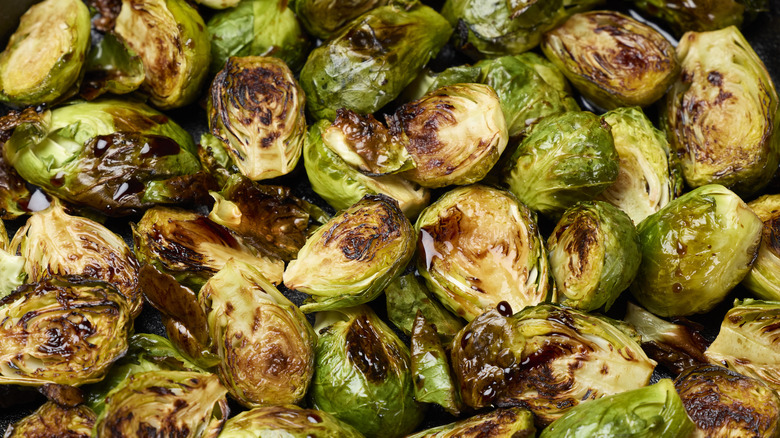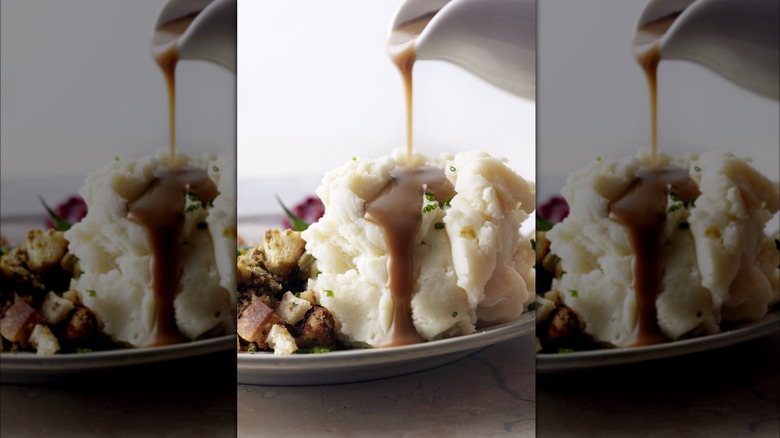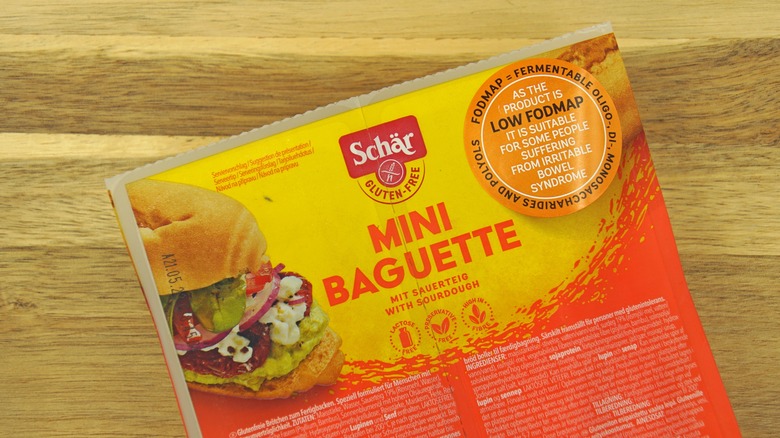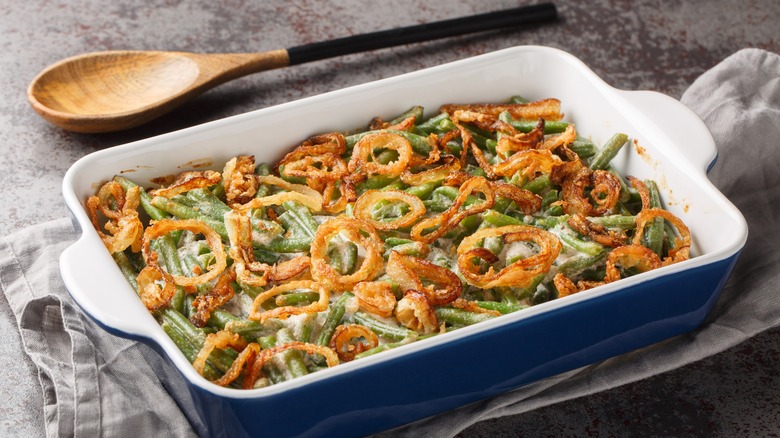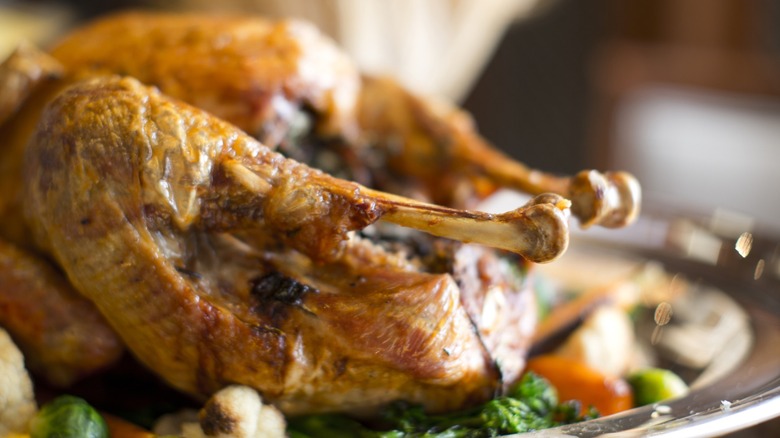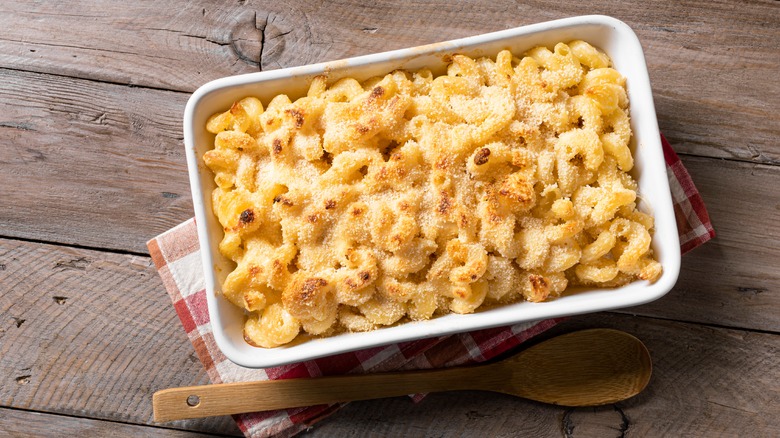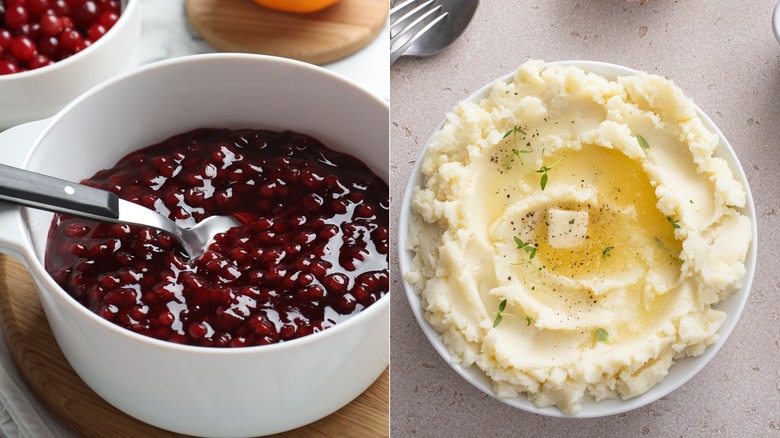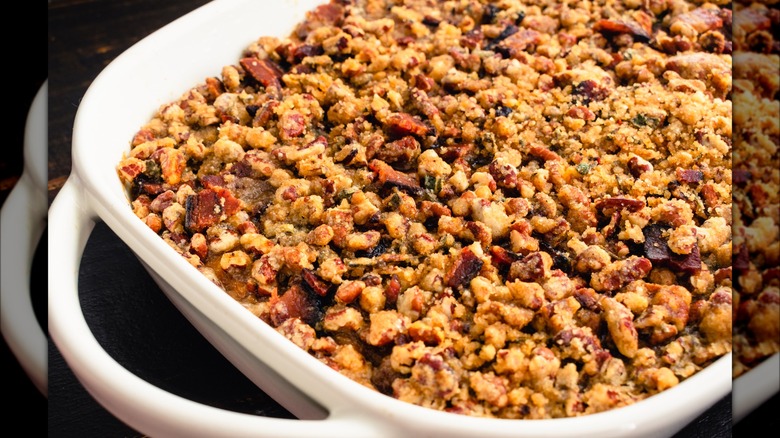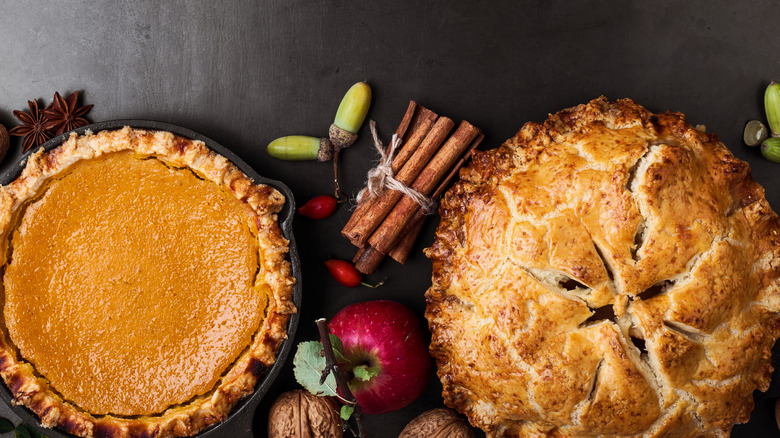The 11 Best Ways To Make Thanksgiving Dinner Gluten-Free
We may receive a commission on purchases made from links.
Thanksgiving, for most Americans, is one of the best food days of the year. There's nothing like sharing a delicious meal with your family and friends, eating special dishes that are reserved for this traditional dinner. For people who have a gluten sensitivity or allergy, it's a whole other story. The joyous day is instead turned into an incredibly stressful one. Will there be any gluten-free desserts? Will the rest of the family think that your gluten-free dishes aren't up to par? Will you accidentally eat something with gluten and not know it, and end your holiday sick in bed?
All of these feelings are incredibly common for people who can't eat gluten. I have been eating gluten-free for three years and have had many trials and errors when navigating this adjustment. On Thanksgiving, there are some dishes that you might not even realize have gluten, and I want to make sure that you're aware of which ones may have gluten and which ones don't. In addition, there are many tips and tricks that I've learned along the way for making classic gluten-filled meals gluten-free. Your friends and family won't even notice the difference!
There is absolutely no reason that those who follow gluten-free diets can't enjoy the food at Thanksgiving just like everyone else. After years of struggling through Thanksgiving dinner and finally figuring out how to still enjoy the delicious meal, I am so excited to share these tips with you.
1. Don't skimp on the gluten-free appetizers
Before you dive into the actual Thanksgiving meal, you're probably going to want to snack on some appetizers while you catch up with your family and enjoy the football game airing on TV. Unfortunately, many common appetizers contain gluten. Some great options for gluten-free appetizers are deviled eggs (a personal favorite), a cheese board with gluten-free crackers, and, of course, the classic chips and dip. Just make sure you stick with potato or corn-based chips, and double check that any dip that is made doesn't have flour as a thickening agent.
If you're in the mood for a fancier appetizer, I have two delicious, yet easy, ideas that all of the guests at Thanksgiving dinner will want to try. The first is a cranberry baked brie. All you need is a wheel of brie cheese and fresh cranberry sauce. The brie can be baked for about 15 minutes in the oven, and then you top it with the cranberry sauce once it's out. Go ahead and dip with some gluten-free crackers, and you'll be in brie-heaven.
Another simple idea is to roast some pecans in the oven with a mixture of butter, garlic powder, mustard powder, Worcestershire sauce, cayenne pepper, and hot sauce on top. This creates an addicting, easy-to-munch-on snack to eat while you wait for the main event.
2. Use a high-quality gluten-free bread for your stuffing
One of the most obviously gluten-filled foods that's commonly eaten at Thanksgiving is stuffing. Stuffing is made primarily from bread, so it's definitely a no-go for the gluten-free folks. Don't lose hope, however. If you want to make your own gluten-free stuffing, it's quite easy. The key is that you have to get high-quality gluten-free bread.
Many gluten-free breads are extremely dry, too sweet, or tend to fall apart. I recommend using Schär bread — which is one of the best gluten-free breads I've ever had. Its deli-style bread is made with rice sourdough and psyllium husk, both of which help make the bread sturdier. It also uses a blend of multiple flours, which generally helps give the bread a better flavor. If you can't find Schär bread, look out for other gluten-free breads with those ingredients and qualities. You can follow almost any stuffing recipe out there with the bread that you choose.
Another option for stuffing, if you're not interested in making it from scratch, is to get a boxed stuffing. Luckily, there are some great gluten-free stuffing brands out there. One brand is Katz, which uses a blend of rice flour with corn, potato, and tapioca starches for the bread, as well as psyllium husk. Another product to consider is Aleias' savory stuffing, which uses a blend of brown and white rice with potato and tapioca starch. Both of these brands have positive reviews from its customers.
3. Lean into vegetable dishes
One great thing about vegetables is that they are all naturally completely gluten-free. Many people tend to push off the idea of having vegetable plates on the table at Thanksgiving — but those are the people who haven't had the right recipes. There are tons of delicious vegetable recipes that will blow the other Thanksgiving side dishes out of the water.
One of my personal favorites is a roasted Brussels sprouts dish. One of the keys to getting Brussels sprouts to crisp up really well is to cut them in half and roast them with their flat sides down. Once the Brussels sprouts are roasted, sprinkle some dried cranberries on top. Then, drizzle a generous amount of balsamic vinegar over the Brussels sprout and cranberry mixture. Lastly, sprinkle with Parmesan cheese. This creates a deliciously tart, crispy, and cheesy Brussels sprouts side.
Another great recipe is a roasted vegetable sheet plate. My favorite vegetables to include in this dish are carrots, butternut squash, red onion, and baby red potatoes. With this recipe, you can take a lot of creative liberties. I personally love to sprinkle them in tons of herbs and seasonings, like rosemary, thyme, paprika, oregano, salt, and pepper. Then, I drizzle honey on top to add an unexpected, sweet flavor into the mixture.
4. Go store-bought or homemade for a gluten-free gravy
Gravy is one of those sneaky food items that can surprisingly have gluten in it. Many recipes call for flour, with the purpose to make the gravy nice and thick. Whether you get your gravy pre-made from a store, or the host of Thanksgiving whips it up themselves, it's a small detail that may slip your mind when making sure you have a gluten-free Thanksgiving dinner.
If you want to opt for grabbing a store-bought, gluten-free gravy, there are some great and cheap options out there. My personal recommendation is to pick up a powdered packet of McCormick gluten-free gravy. Do you prefer the fully pre-made gravy in a carton? McCormick turkey gravy is also gluten-free. I've used both and personally think they taste great. Trader Joe's also has a gluten-free turkey gravy I'm eager to try. But as always, be sure to check the labels. Overall, I tend to find that the store-bought options taste just as good as the regular gluten-filled ones or even homemade — and I appreciate the convenience.
If you'd rather cook your own gravy from scratch, you can either opt out of flour altogether or use a gluten-free alternative. It's generally an easy switch to make, but one of the best products to use is Cup4Cup's multipurpose gluten-free flour. It works well for all types of cooking and baking, making it a perfect substitution to add that extra thickness to your gravy.
5. Make sure you have a good gluten-free bread or rolls
Bread is another food item that can go completely forgotten. You may not even think that it's that necessary, as it's just a filler to add to the table. However, when you see other people dipping their gluten-filled bread rolls into the gravy, you're going to wish that you had prepared better.
I take my gluten-free bread very seriously, and I've tasted tons of brands to find the best options out there. For me, Schär is a no-brainer. Depending on what kind of bread you'd want at your Thanksgiving dinner, Schär probably has it. It offers deli bread (and it's actually the same size as gluten-filled bread), which is great if you want to make a turkey sandwich out of your Thanksgiving leftovers. This brand also has gluten-free ciabatta bread, baguettes, and croissants. There are many grocery stores that carry Schär, like Walmart and ShopRite. You can also order whatever type of bread you'd want right on Schär's website.
Another great option that you can do, also using Schär, is to get the gluten-free puff pastry dough. With this, you can make fresh pastries to eat with your Thanksgiving cheese platter, cranberry sauce, or as a dessert. If you can't tell, I'm a huge fan of this brand. I simply haven't found any other gluten-free bread that stacks up to the quality.
6. Swap these ingredients for a gluten-free take on green bean casserole
Green bean casserole is a Thanksgiving staple that allows everyone to enjoy vegetables in an indulgent way. Most recipes simply call for combining all of your ingredients, baking, and topping with fried onions. But it's unfortunately usually made with gluten-containing bread crumbs, cream of mushroom soup, and soy sauce, so these commonly used ingredients are ones to be aware of. In my experience, none of the following substitutions have affected a green bean casserole taste- or texture-wise.
First and foremost, you're going to need a cream of mushroom soup that's gluten-free. Many popular brands have options on grocery store shelves, like Campbell's, Pacific Foods, and Walmart's Great Value. Next, to make the bread crumbs yourself, I recommend using Whole Foods' 365 gluten-free bread. It's a quality gluten-free bread, but it's also generally sold at an affordable price. If you want to go the store-bought route, I recommend 4C's premium gluten-free bread crumbs. They don't have any sort of mealy taste that gluten-free bread crumbs can sometimes have, and instead are crispy and thin.
Finding gluten-free fried onions unfortunately isn't as easy as finding other ingredients. You can make them yourself by using gluten-free flour, in which case I would again recommend using Cup4Cup multipurpose gluten-free flour. But there aren't that many store-bought options out there. You could try ordering the highly rated Golden Farms' gluten-free fried onions on Amazon, and Acme Organics offers a more affordable option if you can snag a can. Lastly, pick up gluten-free soy sauce (I personally love Kikkomen since it tastes just like regular soy sauce), and you're good to go.
7. Have many different protein dishes in your Thanksgiving spread
It can feel overwhelming having to find gluten-free replacements to make multiple dishes for Thanksgiving. The good news is that all meat protein is naturally gluten-free. However, it's important to always check with the chef that no sort of flour, sauces that may contain gluten, or beer is used when cooking the meat in order to avoid any possible contamination with gluten. If you're safe in that sense, you can go ham (literally)! Now, there's the obvious turkey that you should definitely be chowing down on. But in order to prevent a tryptophan hangover, there are many other protein options to include, as well.
Some families opt for having smaller chicken breasts available at the table, for example. Ham isn't off limits, either, even though that can sometimes be reserved for Christmas. I personally love ham and think it goes together perfectly with a classic Thanksgiving mashed potato side dish. For a non-animal-based protein option, you can always fry up some tofu on the stove, giving it a good crisp so it resembles the texture of meat.
Another non-classic option is to include some seafood. I'm a huge fan of having shrimp cocktail as an appetizer or side, and it's a great way to diversify the table. You could even include a salmon dish and cover it in a Thanksgiving-themed glaze — perhaps with a mixture of honey and pecans. Whatever you choose, you can enjoy these protein options worry-free, especially if creating other gluten-free dishes wasn't possible for your Thanksgiving spread.
8. Enjoy mac and cheese with a gluten-free noodle substitute
Mac and cheese casserole has always been one of my favorite dishes on Thanksgiving. But when I became gluten-free, I was saddened to think that I'd never have that delicious dish again. My thoughts were changed, however, when a friend gave me a completely gluten-free version one year for Friendsgiving. Everyone at the gathering thought that it was a completely regular, gluten-filled casserole and couldn't tell at all that there were substitutions from what they're normally used to eating.
To make this dish gluten-free, my friend made a few adjustments to the recipe. The main ingredient that you need to make sure to have a good alternative for is the noodles. Some gluten-free noodles tend to get a little bit soggy or can fall apart easily, which is the last thing you want in a mac and cheese casserole. A great, sturdy option is the Barilla gluten-free elbow macaroni. These are made with corn flour and rice flour, which tend to make strong, mild-tasting noodles. Chickpea and black bean noodles, in my experience, have a more distinct taste and tend to fall apart easily.
Another ingredient that's commonly used in this casserole is bread crumbs. For this recipe, I'd opt for gluten-free bread crumbs that are ground a bit thinner, as opposed to a panko bread crumb. A good option is Katz's gluten-free plain bread crumbs — a product that's made from a blend of flours and other high-quality ingredients, like egg whites, psyllium husk, and Xanthan gum. It's mild, thin, and crisps up very well when baked.
9. Don't forget the already gluten-free sides
Instead of getting bogged down about what you can't eat at Thanksgiving dinner, focus on what you can. This is especially true if you are attending the dinner elsewhere, where you can't expect the chef to make every single plate gluten-free.
Cranberry sauce is a Thanksgiving staple, and it has incredibly simple ingredients. In its simplest form, it's made with a mixture of cranberries, sugar, and water on the stove — creating a tart yet sweet addition to the holiday spread. As an added bonus, cranberry sauce can also be customized with naturally gluten-free ingredients, like orange zest, pecans, and warming spices. I love to put cranberry sauce on my turkey, but there's no reason to skip out on other delicious cranberry sauce applications. For example, I also save some for dessert as a topping to vanilla ice cream.
Other gluten-free sides that you can dive into are a simple mashed potato or sweet potato dish. Most recipes for both of those are fairly simple and tend to include the addition of gluten-free ingredients like butter or sugar. If you don't see a thick crust coating on either potato dish, you should be in the clear. You can also opt to enjoy the healthier side dishes, like a salad or fruit. With salads, it's always safe to dress it with an oil and vinegar dressing instead of a pre-made one — as pre-made dressings can sometimes contain flour.
10. Use gluten-free flour in your sweet potato casserole's topping
Sweet potato casserole is hands down my absolute favorite thing to eat on Thanksgiving. I specifically love the recipe that my family uses, which includes a delicious brown sugar pecan crust on the top. For the mixture of the sweet potato itself — it's completely gluten-free. It's made with sweet potatoes, eggs, butter, milk, brown sugar, white sugar, vanilla extract, cinnamon, and nutmeg. It is incredibly indulgent and too delicious to ever pass up.
The crust that goes on top of the casserole is the part that isn't normally done gluten-free. However, this is an easy fix. The topping is made with butter, brown sugar, flour, salt, and pecans. For the flour, I recommend King Arthur Baking Company's measure for measure gluten-free flour. This product is great because you can use it as a direct flour substitute, without having to change the measurements. Other brands that don't specify a cup-for-cup ratio will have to measured by weight as opposed to volume, because gluten-free flour tends to be thinner.
The King Arthur flour also has a neutral taste, which is key when using gluten-free flour as a substitute. Sometimes, with gluten-free flours and products, ingredients are used that make them taste a bit off — but that's not the case with the King Arthur flour.
11. Bake your favorite pies with a gluten-free crust
Lastly, and dare I say most importantly, we have desserts. Everyone gets excited about the delicious pies served on Thanksgiving, and it'd be a shame if you couldn't enjoy any of them simply because you can't eat gluten. While you could simply opt for a crustless pie, it's actually incredibly easy to make gluten-free pie crust. So, whether you want to bring one for yourself to the Thanksgiving gathering, or bake every single pie gluten-free for your guests, it's definitely possible.
To make the pie crust yourself, you need a flour that is going to be high quality to avoid the chance of the crust falling apart. For this, I recommend the Cup4Cup pie crust mix. It's a flour specifically made for pie crusts, and it yields a result that is incredibly similar to a regular gluten-filled pie. It has a simple blend of ingredients that includes white and brown rice flour, potato starch, tapioca flour, cornstarch, and Xanthan gum. The latter ingredient provides that oft-missing elasticity to gluten-free baked goods, making your pie crust less likely to fall apart. After using this product multiple times, I've never been disappointed.
If you don't want to make your own crust and prefer to buy a pre-made one, there are some options for that, as well. Wholly Gluten Free, for example, offers 9-inch pie shells that include some similar ingredients. They're available in stores like Whole Foods. I enjoy this brand because it's nice and flaky like a normal gluten-filled crust, and it doesn't completely crumble when you cut into it.
